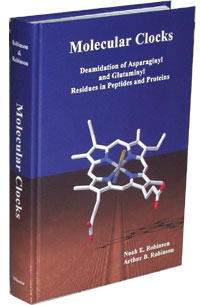Oregon Institute of Science and Medicine
2251 Dick George Road
Cave Junction, OR 97523
(541) 592-4142
|
noah@oism.org |
art@oism.org |
This web site is dedicated to the supply of information about the deamidation of asparaginyl and glutaminyl residues in peptides and proteins. The site began operation in April, 2001.
Of special interest are the computed deamidation rate CD and ID values for all proteins for which 3-dimensional structures are in the Protein Data Bank. Immediate access to CD values for each of the 237,039 Asn in the 17,935 proteins on file in the Protein Data Bank as of January 2003 and the corresponding Asn S parameters and protein ID values is provided by clicking: CD and ID Database.
PDB identifiers for individual proteins are available at www.rcsb.org. Additional CD and ID values for any protein of known 3-dimensional structure that is not listed in this database are available by email request from noah@oism.org. The predicted half-life in days of the amide in 37 °C, pH 7.4, 0.15 M Tris buffer is given by (100)(CD). The predicted half-life for the net deamidation of one amide in a protein, with all amides considered, is given by (100)(ID).
The 443-page book, Molecular Clocks: Deamidation of Asparaginyl and Glutaminyl Residues in Peptides and Proteins by N. E. Robinson and A. B. Robinson provides a complete review of this subject with 1,785 references to the research literature. It can be obtained as listed below.
The book, Molecular Clocks, can also be viewed and read on the Internet at:
http://www.deamidation.org/MolecularClocks.pdf
- Robinson, N. E. and Robinson, A. B. (2001) Molecular Clocks. Proc. Natl. Acad. Sci. USA 98, 944-949.
- Robinson, N. E., Robinson, A. B., and Merrifield, R. B. (2001) Mass Spectrometric Evaluation of Synthetic Peptides as Primary Structure Models for Peptide and Protein Deamidation. J. Peptide Res. 57, 1-12.
- Robinson, N. E. and Robinson, A. B. (2001) Prediction of Protein Deamidation Rates from Primary and Three-Dimensional Structure. Proc. Natl. Acad. Sci. USA 98, 4367-4372.
- Robinson, N. E. and Robinson, A. B. (2001) Deamidation of Human Proteins. Proc. Natl. Acad. Sci. USA 98, 12409-12413.
- Robinson, N. E. (2002) Protein Deamidation. Proc. Natl. Acad. Sci. USA 99, 5283-5288.
- Robinson, N. E. and Robinson, A. B. (2004) Amide Molecular Clocks in Drosophila Proteins: Potential Regulators of Aging and Other Processes. Mechanisms of Ageing and Development 125, 259-267.
- Robinson, N. E., Robinson, Z. W., Robinson, B. R., Robinson, A. L., Robinson, M. R., and Robinson, A. B. (2004) Structure-Dependent Non-enzymatic Deamidation of Glutaminyl and Asparaginyl Pentapeptides. J. Peptide Res. 63, 426-436.
- Robinson, N. E. and Robinson, A. B. (2004) Prediction of Primary Structure Deamidation Rates of Asparaginyl and Glutaminyl Peptides Through Steric and Catalytic Effects. J. Peptide Res. 63, 437-448.
- Robinson, N. E. and Robinson, A. B. (2004) Molecular Clocks: Deamidation of Asparaginyl and Glutaminyl Residues in Peptides and Proteins. Althouse Press, Cave Junction, OR.
Additional research papers on deamidation by these authors as well as other references can be found through Google's Scholar reference search.
The book, Molecular Clocks: Deamidation of Asparaginyl and Glutaminyl Residues in Peptides and Proteins, can be ordered as follows:
Noah E. Robinson and Arthur B. Robinson
Molecular Clocks:
Deamidation of Asparaginyl and Glutaminyl Residues
in Peptides and Proteins
Oregon Institute of Science and Medicine
